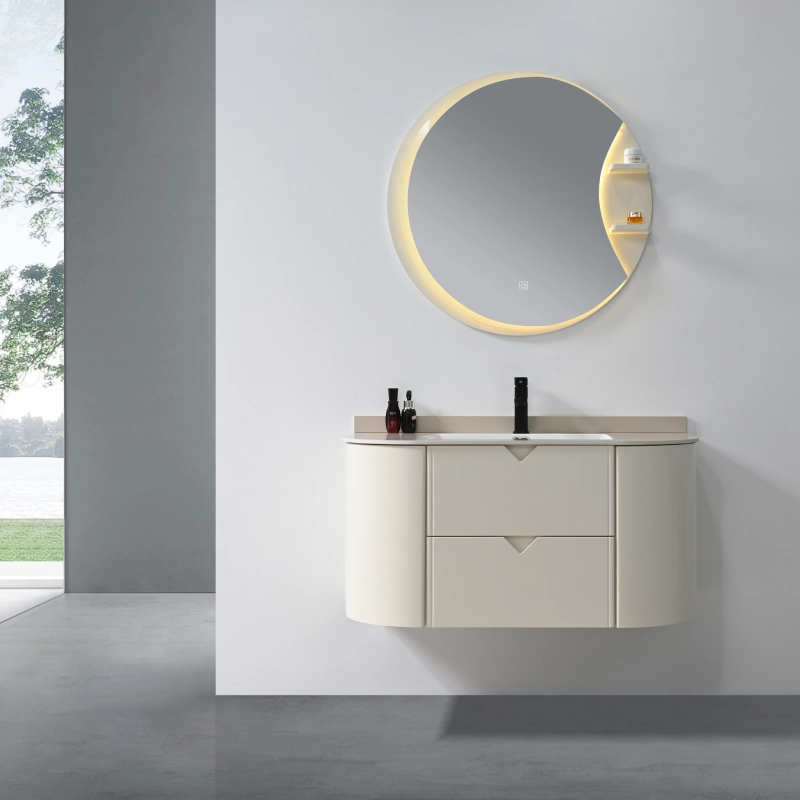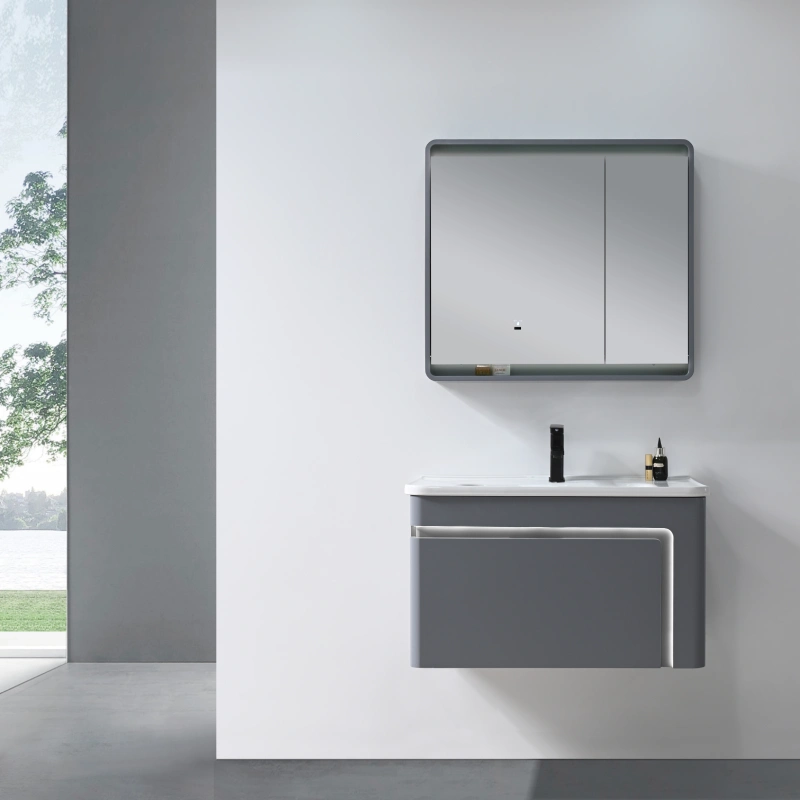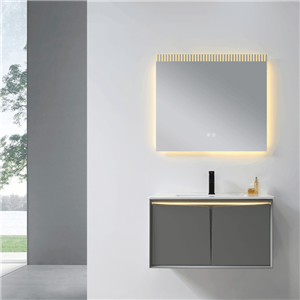What is the Difference Between Bathroom Cabinet and Bathroom Vanity?
Choosing the right bathroom furniture is a crucial step in creating a functional and aesthetically pleasing space. Bathrooms, often considered sanctuaries for relaxation and self-care, require careful planning and design to meet both practical and personal needs. Among the various elements that constitute a well-designed bathroom, the choice between a bathroom cabinet and a bathroom vanity stands out as particularly significant.
What is a Bathroom Vanity?
A bathroom vanity is a central fixture in many bathrooms, combining several essential functions into one unit. It typically includes a sink, a countertop, and storage space, making it a versatile and practical choice for any bathroom design. Understanding the components and benefits of a bathroom vanity can help you appreciate its role and importance in your bathroom.
Definition and Primary Functions
A bathroom vanity is more than just a place to wash your hands. It serves multiple purposes:
Sink Integration: The vanity incorporates a sink, which is essential for daily hygiene routines such as brushing teeth, washing hands, and shaving.
Countertop Space: The countertop provides a surface for placing toiletries, decorative items, and other bathroom essentials. It can be made from various materials such as marble, granite, quartz, or laminate, each offering different aesthetic and functional benefits.
Storage Solutions: Vanities come with built-in storage options like drawers and cabinets, which help in organizing and storing bathroom items such as towels, toiletries, and cleaning supplies. This feature helps keep the bathroom clutter-free and organized.
Common Features and Components
When choosing a bathroom vanity, it's essential to consider its features and components:
Materials: Vanities are available in a range of materials, including wood, MDF (medium-density fiberboard), metal, and glass. The choice of material affects the vanity's durability, appearance, and maintenance needs.
Design Styles: Bathroom vanities come in various styles to match different décor preferences. Popular styles include modern, contemporary, traditional, rustic, and transitional. Each style offers unique design elements, such as sleek lines, ornate details, or a blend of old and new.
Size and Configuration: Vanities vary in size and configuration, from compact single-sink units to larger double-sink models. The size of the vanity should be proportionate to the bathroom space, ensuring it does not overwhelm the room or impede movement.
Understanding these aspects of bathroom vanities will help you select the perfect piece that not only meets your functional needs but also enhances the beauty of your bathroom. In the next section, we will explore bathroom cabinets, another essential component of bathroom furniture.
What is a Bathroom Cabinet?
A bathroom cabinet is a versatile storage solution designed to keep your bathroom organized and clutter-free. Unlike bathroom vanities, which incorporate a sink and countertop, bathroom cabinets focus primarily on providing ample storage space for toiletries, towels, and other bathroom essentials. Understanding the key features and uses of bathroom cabinets can help you make an informed decision when selecting bathroom furniture.
Definition and Primary Functions
A bathroom cabinet is a piece of furniture used to store various items needed in the bathroom. Its primary functions include:
Storage: Providing ample space to store bathroom essentials such as toiletries, cleaning supplies, and linens. This helps in keeping the bathroom tidy and organized.
Accessibility: Ensuring that frequently used items are easily accessible, thereby enhancing the convenience and functionality of the bathroom.
Aesthetic Enhancement: Adding to the overall aesthetic appeal of the bathroom by offering stylish storage options that complement the bathroom's design.
Key Features and Uses
Bathroom cabinets come in various shapes, sizes, and configurations, each designed to serve specific needs:
Wall-Mounted Cabinets: These are attached to the wall, saving floor space and making the bathroom appear larger. They are ideal for storing items at eye level for easy access.
Freestanding Cabinets: These can be placed anywhere in the bathroom and are perfect for adding extra storage without the need for installation. They offer flexibility in terms of placement and can be moved as needed.
Medicine Cabinets: Typically mounted above the sink or vanity, these cabinets often include a mirror on the door and are used to store medications, first aid supplies, and other small items.
Linen Cabinets: Taller cabinets designed specifically for storing towels, linens, and larger items. They usually have a combination of shelves and drawers to accommodate different storage needs.
Typical Styles and Materials
The style and material of a bathroom cabinet can significantly influence the overall look and functionality of your bathroom:
Materials: Common materials used in bathroom cabinets include wood, MDF (medium-density fiberboard), metal, and plastic. Each material offers different benefits in terms of durability, maintenance, and aesthetics. For example, solid wood cabinets offer a classic, timeless look but require more maintenance, while MDF cabinets are more affordable and easier to maintain.
Styles: Bathroom cabinets come in various styles to match different décor preferences:
Modern: Sleek, minimalist designs with clean lines and often made from materials like glass and metal.
Traditional: Featuring ornate details, rich wood finishes, and classic hardware for an elegant, timeless look.
Rustic: Using natural or reclaimed wood with distressed finishes to create a warm, cozy atmosphere.
Transitional: Combining elements from both modern and traditional designs, offering a balanced and versatile aesthetic.
Common Uses of Bathroom Cabinets
To illustrate the versatility of bathroom cabinets, here are a few examples of how they can be used:
Organizing Toiletries: Wall-mounted or freestanding cabinets can be used to store everyday items like toothpaste, hair products, and skincare items, keeping them easily accessible yet neatly tucked away.
Storing Towels and Linens: Linen cabinets provide a dedicated space for storing clean towels and extra linens, helping to keep the bathroom organized and free from clutter.
Housing Cleaning Supplies: Cabinets can be used to store cleaning products, ensuring they are kept out of sight but within easy reach when needed.
By understanding the various types and functions of bathroom cabinets, you can choose the right piece that meets your storage needs while complementing your bathroom's design. In the next section, we will discuss how to choose between a bathroom vanity and a bathroom cabinet, taking into consideration your specific requirements and preferences.
What are the Key Differences Between Bathroom Vanity and Bathroom Cabinet?
Understanding the key differences between a bathroom vanity and a bathroom cabinet is crucial in making an informed decision for your bathroom design. While both serve essential functions, their features, uses, and benefits vary significantly. This section will highlight these differences, helping you to choose the right option for your needs.
Structural Differences
Bathroom Vanity:
Integration: A bathroom vanity typically integrates a sink, countertop, and storage space into a single unit. This integration makes it a multifunctional piece of furniture.
Plumbing: Vanities are designed to accommodate plumbing for the sink, which may require more complex installation processes.
Bathroom Cabinet:
Modularity: A bathroom cabinet is primarily a storage unit, which can be placed independently or in conjunction with other fixtures. It does not include a sink or countertop.
Flexibility: Cabinets can be wall-mounted or freestanding, offering more flexibility in terms of placement and design. They are easier to install as they do not require plumbing adjustments.
Design and Aesthetics
Bathroom Vanity:
Focal Point: Vanities often serve as a centerpiece in the bathroom, enhancing the room's overall design and style. They come in a variety of styles, from modern to traditional, allowing you to choose one that matches your décor.
Materials and Finishes: Vanities are available in a range of materials such as wood, metal, and glass, with various finishes to suit different aesthetic preferences.
Bathroom Cabinet:
Complementary: Cabinets are generally more understated and serve to complement other bathroom fixtures. They focus more on functionality rather than being a design focal point.
Versatility: Cabinets are versatile and can be matched with a variety of design styles. They can blend seamlessly with the bathroom's overall look or provide a contrasting element for visual interest.
Functional Differences
Bathroom Vanity:
Multifunctionality: A vanity combines the functions of a sink, countertop, and storage, making it a practical choice for small to medium-sized bathrooms where space optimization is important.
Daily Use: Vanities are designed for everyday use, providing a convenient space for daily grooming and hygiene routines.
Bathroom Cabinet:
Dedicated Storage: Cabinets offer dedicated storage solutions, helping to keep the bathroom organized. They are ideal for storing toiletries, towels, and other bathroom essentials.
Space Saving: Wall-mounted cabinets save floor space and make the bathroom appear larger, while freestanding cabinets can be moved and repositioned as needed.
By considering these key differences, you can better understand which option aligns with your specific needs and preferences. Whether you prioritize multifunctionality, aesthetic appeal, or storage capacity, knowing the distinctions between a bathroom vanity and a bathroom cabinet will guide you in making the best choice for your bathroom.





